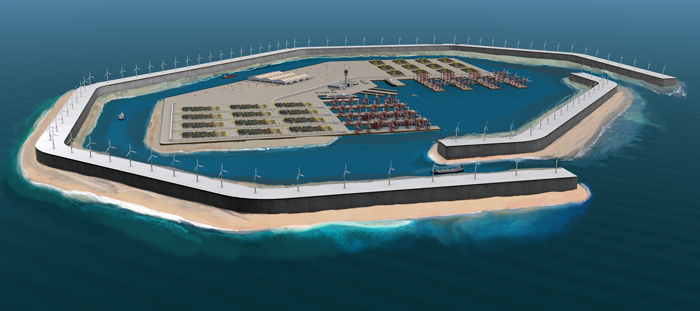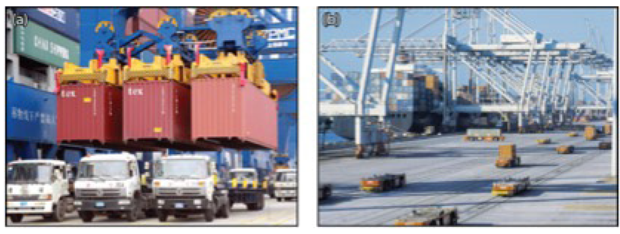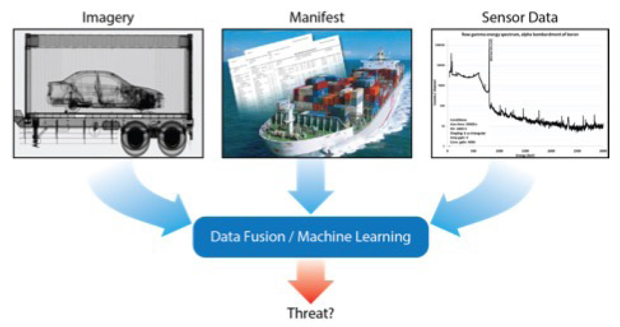The Portunus platform is designed to increase security of ports and improve economics of maritime shipping. The Portunus Concept is a national network of offshore ports close enough to shore to support hub-and-spoke maritime commerce, while removing the threats posed by weapons of mass destruction.
The Challenge
U.S. Ports Face Economic, Environmental, and Security Challenges
The largest-capacity container vessels on transocean routes have gone from 8,000 TEUs in 2000 to more than 19,000 TEUs in 2015 (TEU = 20 foot equivalent unit). While this provides an economy of scale that benefits many cargo owners and shipping companies, it also puts physical, financial and operational pressures on U.S. ports. To vie for market share, ports are forced to dredge, retool cranes, and update inland intermodal connections. Yet even with $46 billion in recent port investment, U.S. ports lag in capacity and efficiency compared to the largest ports in Europe and Asia. Ports are also entry points for human trafficking and the smuggling of drugs and weapons, and they could be transit points or targets of chemical, biological, or nuclear weapons of mass destruction (WMD). Because the transhipment of goods through ports is a vital economic activity, any disruption from WMDs poses not only a threat to human life but to the economy.
The Solution
Offshore Hub-and-Spoke System Increases Efficiency
Researchers at Lawrence Livermore National Laboratory have proposed the Portunus concept, a network of offshore ports that would serve as a hub-and-spoke distribution system for maritime shipping. These offshore platforms would be large enough to accommodate the 19,000+ TEU ships that only a few U.S. ports are equipped to handle and be able to berth the ever larger ships currently planned.
Smaller Jones Act vessels would transport goods to and from Portunus platforms for U.S. distribution, while the larger oceangoing vessels handle transocean transport. The concept couples the most efficient ways to move goods across both the ocean (through ultralarge container ships) and domestically (by short-sea shipping) with a port designed from the ground up to cut freight offload times and protect lives and critical infrastructure.
Bechtel International estimated that offshore ports in the eastern U.S. could produce 20 to 30 percent savings on direct freight costs from the Far East (all-water economy of larger shipping), 30 to 40 percent savings on direct freight costs (shorter overland transport) and 20 to 50 percent savings in emissions (lower fuel consumption). Because the law requires that U.S.-made and -registered vessels carry containers from point to point within U.S. territorial waters, the construction of Portunus-style platforms could help jumpstart the U.S. maritime industry and create new jobs. Portunus is also a potential source of spin-off technologies and benefits for industries such as offshore wind and wave power, as well as desalinization and aquaculture.
Portunus Concept Offshores Risk
The offshore platform concept is not a new one—such ports are under construction now in other parts of the world—but Livermore proposes to develop Portunus platforms that are especially designed for efficient transhipment and security adapted to regional needs. Ports are designed for the loading or offloading of large vessels. Automated guided vehicles carry containerized freight to a security and inspections area that separates international and domestic activity.
In this area, imaging and detection technologies—some of which are currently in development—screen for human trafficking, radiological and nuclear materials, chemical and biological weapons, and contraband. With Portunus, stationary detection bays surround each container and take advantage of time-distance-shielding relationships, scanning one container at a time. We can potentially use active interrogation methodologies for maximum benefit and achieve 100% scanning prior to allowing entry into the U.S. High-speed computational capabilities and data warehouses compare results against electronic manifests and other records.
Relationship to LLNL’s Mission
The Portunus project fulfills Livermore’s security mission in several ways. It furthers Livermore’s mission in counterterrorism, which is to prevent and mitigate potentially catastrophic incidents involving chemical, biological, radiological, nuclear, or high explosive materials. The work also advances Livermore’s mission to address nonproliferation through innovative technical solutions. The potential spinoffs of Portunus advance the nation’s energy security through the production of clean energy resources that reduce environmental impacts, and its economic security by providing technology that generates domestic economic activity.
Portunus Engages Livermore’s Technological Strengths
Further development of the Portunus concept will engage a variety of Livermore’s scientific and engineering disciplines, including its expertise in the design of detector technology, as well as big data, and high-performance computing (HPC). The large open-ocean structures of Portunus are unprecedented and will use the Laboratory’s engineering design expertise as well as its HPC systems for design simulation. Livermore computational and machine learning expertise can help develop the information systems needed for correlating large volumes of electronic manifest data with detector data. The technology development in these areas can then be applied to other Laboratory mission areas.
Numerous Partners Will Help Make It Happen
Livermore is working with a variety of partners to advance the Portunus concept. The University of California is contributing engineering expertise. Bechtel Engineering is contributing its knowledge of offshore port design and construction. The American Bureau of Shipping provides design review and certification, while RAND will provide research in economic analysis of Portunus impacts. The National Oceanic and Atmospheric Administration provides ocean data needed for simulation work. Livermore is now working with these partners, and many others to advance Portunus to the feasibility study stage.
Download Portunus Project Fact Sheet







